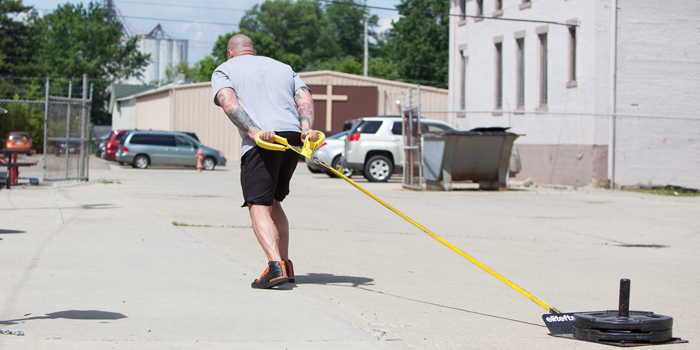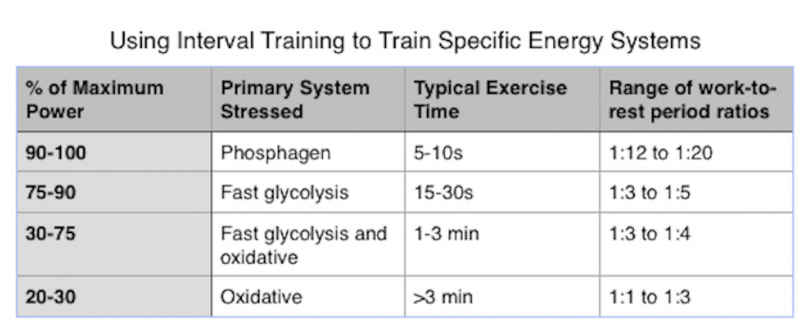
Conditioning work does not have to be boring, nor does it have to beat you up. General physical preparedness (GPP) work can add value to your training sessions and also break up the monotony. GPP-based conditioning will allow you to enhance recovery and build your base, making you more able to tolerate higher volume and recover from your other training sessions. The purpose of your GPP work can be multifaceted, and thus serve multiple purposes if implemented into a well-developed training plan.
Sled work fits the bill perfectly for these purposes. This type of work is perfect for individuals who:
- ...want to shred body fat.
- ...are on a training regimen, but want additional work that won't take away from the objectives of their current training plan.
- ...want to improve their conditioning both anaerobically and aerobically.
- ...want to spice up their current training regiment without feeling run-down.
Let's talk about how to incorporate sled work into your training schedule so that it doesn't interfere with your current training program, while still allowing you to improve your conditioning in a balanced manner. First off, we are going to implement this conditioning in a manner that allows us to work all three energy systems. These sessions will have at least 48 hours of recovery between each session.
A typical weekly breakdown will look something like this:
Day 1
- Maximal Aerobic Endurance (ATP-CP)
- Empty sled sprint work with full recovery between bouts
- Efforts will be 100% and recovery will be 15 to 20 times longer than the amount of work.
- Heart rate will be near maximal (95% to 100% of MHR).
Day 2
- Basic Endurance, Zone 2 (Oxidative System)
- Longer duration sled work and loaded carries
This will be an accumulation of volume with small intervals of rest as needed or straight sets. There are few ways we can go about incorporating this work.
Day 3
- Transitional Anaerobic Power (Phosphagen/Glycolytic System)
- Heavy sled work with nearly complete recovery between sets
Now that we know how each day will break down, let's talk about the specifics of each session and the training intent. As you can see from above, we are targeting each energy system specifically so that we are able to adhere to the basic principles of energy system work and ensure we are getting the most from each session.
Here are some specific examples:
Day 1
- Empty Sled Sprints: 10 x 50 yards
- Rest 2:00
- We are looking for 100% effort here and roughly 10 seconds of total work each set. Two minutes of rest between sets may seem like too much after the first sets, but that will change over the course of the workout. Remember, we should be able to sustain our efforts for all sets, meaning if it takes you 10 seconds to hit 50 yards on set one, it should take you 10 seconds to hit 50 yards on set 10. Also, if needed adjust the load and distance. Depending on your sled type, surface, and ability, this could influence the outcome of each set. As long as you're able to move at an all-out sprint each set and perform the work in 15 seconds or less, you'll be right where you need to be. Otherwise, make the necessary changes.
Day 2
20 Minutes on the Clock:
- Sled push x 50 yards, moderate weight. This should not be a sprint and more resemble a "power walk."
- Front rack double kettlebell carry x 50 yards, as heavy as possible with perfect form.
- Walk-rest 100 meters between sets. This should be "low intensity" work. If you wear a heart rate monitor your heart rate should not go higher than 70% to 75% of max. The intent here is moving at a pace that is almost conversational. Focus on quality, not quantity.
Day 3
- Heavy sled push, 4 x 20 yards at build-in weight each set. Rest as needed. Perform regularly scheduled workout.
- Heavy sled push, 5 x 20 yards at highest weight achieved from the first push. Rest 90 seconds.
- You can rest as much as you need to between sets of part one in order to be fully recovered for your next set, but when performing part two you will need full recovery between sets. Keep in mind that part one will serve as a warm-up and set the stage for part two. Your last set of part one will most likely be your only true "work set."
This work can be varied quite easily to keep things fresh, but the most important thing to remember with these sessions is the overall intent. The level of intensity varies with each session, but if we are mindful of the constraints we already laid out, arriving at the desired stimulus each session will be doable. One of the best aspects of performing conditioning work with a sled is that it's efficient, it can be varied a number of ways, and it does not take away from other aspects of your current training programming. Overall, this approach will allow you to enhance recovery, improve your conditioning, and lose body fat.











I should have known this was a bogus article when I saw:
"1....want to shred body fat"